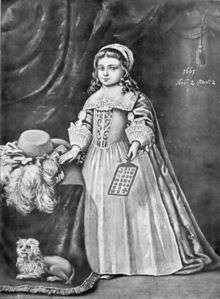Hornbook
A hornbook is a book that serves as primer for study. The hornbook originated in England as long ago as 1450,[1] or earlier.[2] The term has been applied to a few different study materials in different fields. In children's education, in the years before modern educational materials were used, it referred to a leaf or page displaying the alphabet, religious materials, etc., covered with a transparent sheet of horn (or mica) and attached to a frame provided with a handle.[3]
.jpg)
Use in United States legal education
In United States law, a hornbook is a text that gives an overview of a particular area of law. A law hornbook is a type of treatise, usually one volume, which could be a briefer version of a longer, multi-volume treatise. Students in American law schools often use hornbooks as supplements to casebooks.
Use in early childhood education
In childhood education from the mid-16th century to the late 19th century, a hornbook was a primer for children consisting of a sheet containing the letters of the alphabet, mounted on wood, bone, leather, or stone and protected by a thin sheet of transparent horn or mica. Sometimes the sheet was simply pasted against the slice of horn. The wooden frame often had a handle, and it was usually hung at the child's girdle. The sheet, which was first of vellum and later of paper, contained first a large cross, from which the horn-book was called the Christ Cross Row, or criss-cross-row. The alphabet in large and small letters followed. The vowels then formed a line, and their combinations with the consonants were given in a tabular form. The usual Trinitarian formula – "in the name of the Father and of the Sonne and of the Holy Ghost, Amen" – followed, then the Lord's Prayer, the whole concluding with the Roman numerals.
In art, entertainment, and media
- The hornbook is mentioned in William Shakespeare's Love's Labour's Lost (written in the mid-1590s), act 5, scene 1, where Moth refers to the ba, the a, e, i, o, u, and the horn:
- ARMADO. [To HOLOFERNES] Monsieur, are you not lett'red?
- MOTH. Yes, he teaches boys the hornbook. What is a, b, spelt backward with the horn on his head?
- HOLOFERNES. Ba, pueritia, with a horn added.
- MOTH. Ba, most silly sheep with a horn. You hear his learning.
- HOLOnant?
- MOTH. The third of the five vowels, if You repeat them; or the fifth, if I.
- HOLOFERNES. I will repeat them: a, e, I—
- MOTH. The sheep; the other two concludes it: o, U.
- Ben Jonson also describes it in his play Volpone (1605–06), act 4, scene 2:
- CORVINO: ... And yet I hope that I may say, these eyes
Have seen her glued unto that piece of cedar,
That fine well-timber'd gallant; and that here
The letters may be read, through the horn,
That make the story perfect.
- Robert Burns, in his poem Death and Doctor Hornbook (1785), refers to a local schoolmaster with a sideline as an apothecary, as Doctor Hornbook.[4]
References
- Huey, Edmund B. (1908). The Psychology and Pedagogy of Reading. New York: The MacMillan Company. p. 244.
- Plimpton, George A. "The Hornbook and Its Use in America". Proceedings of the American Antiquarian Society 26 (1916): 264-72.
- Definition of hornbook from dictionary.com
- "Complete Works: Death and Doctor Hornbook: A True Story". Burns Country. 1785.
![]()
| Wikimedia Commons has media related to Hornbook. |
External links
| Wikiquote has quotations related to: Hornbook |
